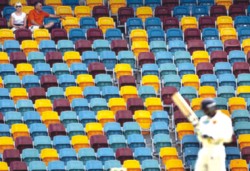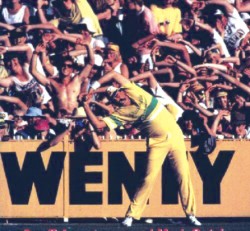|
 Impressions Impressions
Stadium Arcadium
Nader Rahman
To a whole generation of sports fans, there is possibly nothing better than watching a live game on television. It eliminates all the problems of going to the stadium. No tickets to buy (often extremely over priced), no car to park, no lines to queue, no sweaty people to sit next to and best of all, no replays. In England there is the rustic charm of watching a leisurely day's cricket, often with a book in hand to bide them time. In the subcontinent there is no such charm. Thousands of people cram themselves into stadiums, which mirror the colosseum, and they expect to see nothing less than their man made God's perform like titans. It is usually hot and sweaty, with no place to sit, no real facilities and terrible food and in England they have the gall to complain about warm beer.
That being said, there is nothing greater than watching cricket at a stadium and while it has its problems in Bangladesh and around the world, there is a certain X-factor about being at a stadium that gives one goose bumps. Neville Cardus, E.W. Swanton and a host of other cricketing Shakespeares are probably turning in their graves. Their careers, were built around the allure of watching a gentle days play, sipping tea, eating cake and always reminiscing about the good old days. For them cricket was unquestionably spectator sport, and everything that the game stood for could be learned and taught from the stands. Times have changed and while I still believe in the value of watching the game live, it is understandable why so many would prefer the comfort of home over the sauna like atmosphere of the stadium.
 For the subcontinent and specially Bangladesh, there is nothing we can do about the weather. It is the most common deterrent from actually going to see a live game, but there are some measures that can be taken to try and make the place as comfortable as possible. The first step would be to print fewer tickets, now there is an obvious disadvantage to this suggestion. Fewer people can attend a match and it may disgruntle some people who wanted to attend. In some extreme cases it may frustrate people from wanting to see a match in the future, but that is a risk we will have to take. With sultry weather more or less constant around the year, there can be nothing worse than going to an over crowded stadium and being surrounded by sweaty individuals who are having just as bad a time as you. For the subcontinent and specially Bangladesh, there is nothing we can do about the weather. It is the most common deterrent from actually going to see a live game, but there are some measures that can be taken to try and make the place as comfortable as possible. The first step would be to print fewer tickets, now there is an obvious disadvantage to this suggestion. Fewer people can attend a match and it may disgruntle some people who wanted to attend. In some extreme cases it may frustrate people from wanting to see a match in the future, but that is a risk we will have to take. With sultry weather more or less constant around the year, there can be nothing worse than going to an over crowded stadium and being surrounded by sweaty individuals who are having just as bad a time as you.
If the capacity of a stadium is 30,000 then no more than 25,000 tickets should be made available. There will be a loss in revenue and some may feel outraged, but the benefits of giving fans breathing space will be felt in the future. If they enjoy themselves at the stadium, then they will be more than happy to come back again, and by giving the spectators some breathing room and personal space all you are doing is making the environment just a little more bearable. In 1966/7 Eden Gardens was almost burnt to the ground as a mob set fire to the stadium after local authorities sold more tickets than they had seats available. The Indian and West Indian teams came away from the carnage unscathed, but it could have been a different story. We do not want to recreate scenes like that.
The VIP galleries at Shere Bangla National Stadium in Mirpur show us what can be done if enough effort is put into it. They have revolving fans, which offer the spectators some respite from the oppressive heat. That is something that should be mimicked around the stadium, most importantly in the galleries where people are crammed in like sardines. If fewer tickets are sold, and if revolving fans are provided, it would greatly improve the over all experience. There is an implicit acceptance that the people who pay a large amount of money for their tickets will not tamper with the fans, and that same respect must be shared with the entire crowd. Special enclosures around grounds are covered with shamianas and that is a step in the right direction and already those seats have become highly coveted. While it would be impossible to provide shamianas for the main galleries, fewer people and fans would make up a great deal for the heat.
 The food and beverage facilities must also be taken up a notch. Currently drinks and food are sold at exorbitant prices inside the stadium and it puts people off. Most annoyingly the drinks are all room temperature, there can be nothing worse than queuing up in the heat for a drink and then paying Tk 25 for a cup of warm soda. How can people possibly enjoy themselves if they are served lukewarm drinks on a hot day. There are drinks sponsors and they seem to be getting away with anything they want. If they really are to earn their keep then the least they should do is satisfy their customers and provide the spectators with a cool drink. The food is not bad although still pricey but the problem with the food is what to do when the meal is over. After having a hearty meal of biriyani or tehari one is usually left with an oily hand to wash, which proves to be impossible at the stadium. The food and beverage facilities must also be taken up a notch. Currently drinks and food are sold at exorbitant prices inside the stadium and it puts people off. Most annoyingly the drinks are all room temperature, there can be nothing worse than queuing up in the heat for a drink and then paying Tk 25 for a cup of warm soda. How can people possibly enjoy themselves if they are served lukewarm drinks on a hot day. There are drinks sponsors and they seem to be getting away with anything they want. If they really are to earn their keep then the least they should do is satisfy their customers and provide the spectators with a cool drink. The food is not bad although still pricey but the problem with the food is what to do when the meal is over. After having a hearty meal of biriyani or tehari one is usually left with an oily hand to wash, which proves to be impossible at the stadium.
The bathrooms at the stadium are in shambles and resemble truck stop out houses rather than rest rooms at an international sporting arena. It cannot be explained how putrid and disgusting these black holes are. Forget washing your hands, I would think twice before even walking in front of it. This is an issue that must be tackled if we are to attract people back to stadiums to watch cricket and of all the suggestions it seems the most expensive, yet it would be an investment, which everyone who has been to a stadium would greatly welcome. I have not added things like big screen TV's which have become quite commonplace around the world, or even half time shows which could have an element of audience interaction. These are all bonuses, but for cricket to remain a spectator sport the crowds must be enticed back. We must provide them with an environment which they will want to return to, over and over again. In England, Australia and South Africa they have the advantage beautiful weather and stunning stadiums. We hold no such advantage, and have to make do with what we have at our disposal. One-day matches are reasonably well attended here, but test matches are still played in front of empty stands.
If we can bring the crowds back we will be saving a generation from watching cricket in front of a television screen. There is something magical about being at the stadium, smelling the grass and seeing ones heroes' play an arms length away. Watching the fields change over, the batsmen chat amongst themselves and umpires dawdle to their positions are all missed by an ad break. Cardus and Swanton spent countless summers at the grounds and reading their words is like being transported to a time when the game was just a game, the batsmen walked and umpires decision was never questioned. All of that may have changed, but what they described from the stands can still be felt if one merely walks into a stadium, now all we need to do is keep them there.
Copyright
(R) thedailystar.net 2008 |
|
